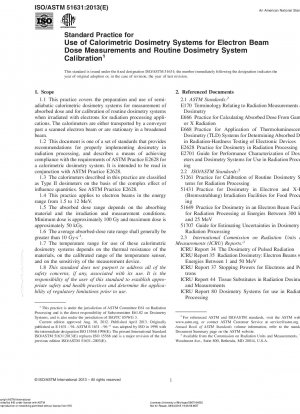ASTM ISO/ASTM 51631-13
Standard Practice for Use of Calorimetric Dosimetry Systems for Electron Beam Dose Measurements and Routine Dosimeter Calibration
- Standard No.
- ASTM ISO/ASTM 51631-13
- Release Date
- 2013
- Published By
- American Society for Testing and Materials (ASTM)
- Status
- Replace By
- ASTM ISO/ASTM 51631-20
- Latest
- ASTM ISO/ASTM 51631-20
- Scope
4.1 This practice is applicable to the use of calorimetric dosimetry systems for the measurement of absorbed dose in electron beams, the qualification of electron irradiation facilities, periodic checks of operating parameters of electron irradiation facilities, and calibration of other dosimetry systems in electron beams. Calorimetric dosimetry systems are most suitable for dose measurement at electron accelerators utilizing conveyor systems for transport of product during irradiation.
NOTE 18212;For additional information on calorimetric dosimetry system operation and use, see ICRU Report 80. For additional information on the use of dosimetry in electron accelerator facilities, see ISO/ASTM Practices 51431 and 51649, and ICRU Reports 34 and 35, and Refs (1-3).
4.2 The calorimetric dosimetry systems described in this practice are not primary standard dosimetry systems. The calorimeters are classified as Type II dosimeters (ASTM E2628). They may be used as internal standards at an electron beam irradiation facility, including being used as transfer standard dosimetry systems for calibration of other dosimetry systems, or they may be used as routine dosimeters. The calorimetric dosimetry systems are calibrated by comparison with transfer-standard dosimeters.
4.3 The dose measurement is based on the measurement of the temperature rise in an absorber (calorimetric body) irradiated by an electron beam. Different absorbing materials are used, but the response is usually defined in terms of dose to water.
NOTE 28212;The calorimetric bodies of the calorimeters described in this practice are made from low atomic number materials. The electron fluences within these calorimetric bodies are almost independent of energy when irradiated with electron beams of 1.5 MeV or higher, and the mass collision stopping powers are approximately the same for these materials.
4.4 The absorbed dose in other materials irradiated under equivalent conditions may be calculated. Procedures for making such calculations are given in ASTM Practices E666 and E668, and Ref (1).
4.4.1 Calorimeters for use at industrial electron accelerators have been constructed using graphite, polystyrene or a Petri dish filled with water as the calorimetric body (4-10). The thickness of the calorimetric body shall be less than the range of the electrons.
4.4.2 Polymeric materials other than polystyrene may also be used for calorimetric measurements. Polystyrene is used because it is known to be resistant to radiation (11) and because almost no exo- or endothermic reactions take place (12).
1.1 This practice covers the preparation and use of semiadiabatic calorimetric dosimetry systems for measurement of absorbed dose and for calibration of routine dosimetry systems when irradiated with electrons for radiation processing applications. The calorimeters are either transported by a conveyor past a scanned electron beam or are stationary in a broadened beam.
1.2 This document is one of a set of standards that provides recommendations for properly implementing dosimetry in radiation processing, and describes a means of achieving compliance with the requirements ofASTM Practice E2628 for a calorimetric dosimetry system. It is intended to be read in conjunction with ASTM Practice E2628.
1.3 The calorimeters described in this practice are classified as Type II dosimeters on the basis of the complex effect of influence quantities. See ASTM Practice E2628.
1.4 This practice applies to electron beams in the energy range from 1.5 to 12 MeV.
1.5 The absorbed dose range depends on the absorbing material and the irradiation and measurement conditions. Minimum dose is approximately 100 Gy and maximum dose is approximately 50 kGy.
1.6 The average absorbed-dose rate range shall generally be greater than 10 Gy183;s-1.
1.7 The temperature range for use of these calorimetric dosimetry systems d......
ASTM ISO/ASTM 51631-13 Referenced Document
- ASTM E170 Standard Terminology Relating to Radiation Measurements and Dosimetry
- ASTM E2628 Practice for Dosimetry in Radiation Processing
- ASTM E2701 Standard Guide for Performance Characterization of Dosimeters and Dosimetry Systems for Use in Radiation Processing
- ASTM E666 Standard Practice for Calculating Absorbed Dose From Gamma or X Radiation
- ASTM E668 Standard Practice for Application of Thermoluminescence-Dosimetry (TLD) Systems for Determining Absorbed Dose in Radiation-Hardness Testing of Electronic Devices
ASTM ISO/ASTM 51631-13 history
- 2019 ASTM ISO/ASTM 51631-20 Standard Practice for Use of Calorimetric Dosimetry Systems for Dose Measurements and Routine Dosimetry System Calibration in Electron Beams
- 2013 ASTM ISO/ASTM 51631-13 Standard Practice for Use of Calorimetric Dosimetry Systems for Electron Beam Dose Measurements and Routine Dosimeter Calibration
- 2003 ASTM ISO/ASTM 51631-03 Standard Practice for Use of Calorimetric Dosimetry Systems for Electron Beam Dose Measurements and Routine Dosimeter Calibration
- 2002 ASTM ISO/ASTM 51631-02 Standard Practice for Use of Calorimetric Dosimetry Systems for Electron Beam Dose Measurements and Dosimeter Calibrations
